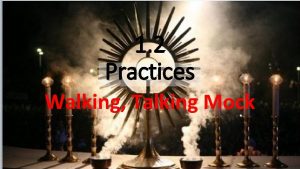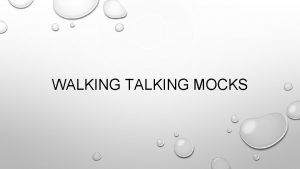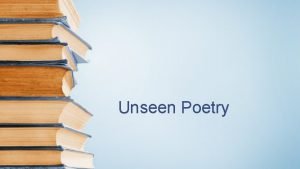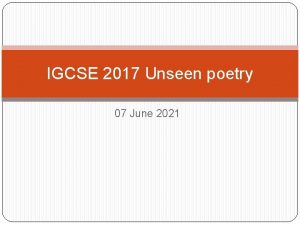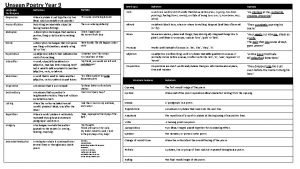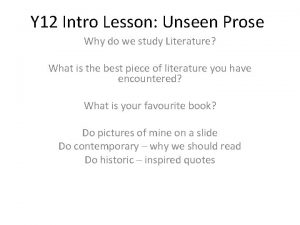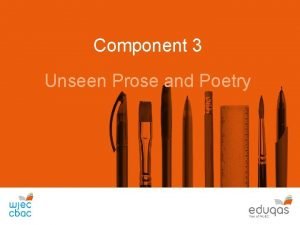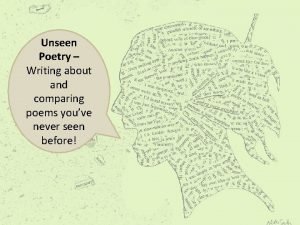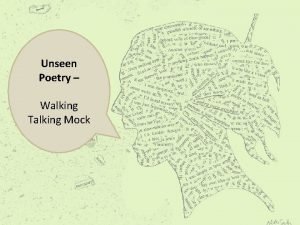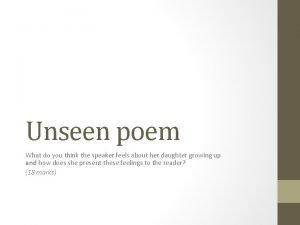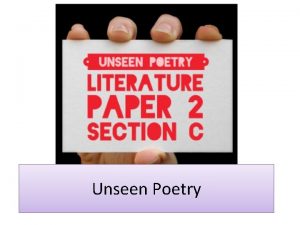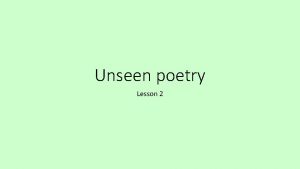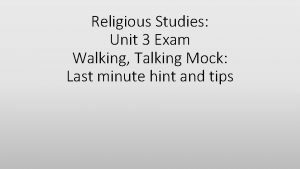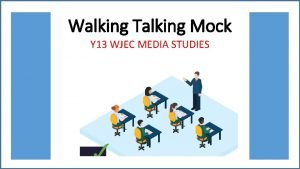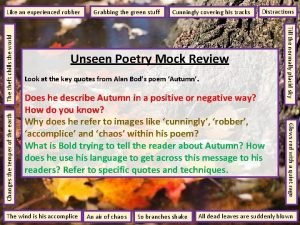Unseen Poetry Walking Talking Mock Conflict poetry Unseen















- Slides: 15

Unseen Poetry – Walking Talking Mock

Conflict poetry Unseen Timings: AIC – 45 mins Conflict Poetry – 45 mins Unseen Poetry – 30 mins, then 15 mins Your Literature Paper 2 exam will contain a question on Conflict poetry and a question on unseen poetry. Both questions ask you to compare.

Conflict poetry Unseen Timings: AIC – 45 mins Conflict Poetry – 45 mins Unseen Poetry – 30 mins, then 15 mins Your Literature Paper 2 exam will contain a question on Conflict poetry and a question on unseen poetry. The unseen poetry question is in two parts: 1. You analyse one unseen poem (24 marks) 2. You compare it to a second unseen poem (8 marks)

Spend 30 mins on this section – 10 mins reading and planning; 20 mins writing

Part 1 Mark Scheme Level 6 • Critical, exploratory conceptualised response to task and text Convincing, critical • Judicious use of precise references to support interpretation(s) analysis and • Analysis of writer’s methods with subject terminology used judiciously exploration • Exploration of effects of writer’s methods on reader 21 -24 marks (8+) Level 5 • Thoughtful, developed response to task and text Thoughtful, • Apt references integrated into interpretation(s) developed • Examination of writer’s methods with subject terminology used consideration effectively to support consideration of methods 17 -20 marks (6+) • Examination of effects of writer’s methods on reader Level 4 • Clear, explained response to task and text Clear • Effective use of references to support explanation understanding • Clear explanation of writer’s methods with appropriate use of relevant 13 -16 marks (4+) subject terminology • Understanding of effects of writer’s methods on reader Level 3 Explained, structured comments 9 -12 marks (3+) • Some explained response to task and text • References used to support a range of relevant comments • Explained/relevant comments on writer’s methods with some relevant use of subject terminology • Identification of effects of writer’s methods on reader

Step 1 – have some ideas about poem 1! Hint: use the focus of section (b) to help you figure out what to look for! Spend 10 minutes reading and planning

Spend 10 minutes reading and planning

Step 2 – write up your ideas about poem 1 Spend 20 minutes writing up your answer Consider: • Title, subject and voice • Feelings/mood • Message/theme How are these created by language; structure; imagery?

In this poem, the speaker is the voice of a parent, describing a memory of watching her daughter learn to ride a bike. The mother describes her fear of her daughter coming to harm with the use of ‘loping along beside you’, as if she is terrified of letting go and letting her daughter move away from her. This is then reinforced with the use of ‘wobbled’ to suggest the daughter’s vulnerability and fear that she may come to harm. However, the daughter is confident and shows this through ‘pulled away’ and ‘screaming with laughter’ – she doesn’t appear to have any fear of her new skill and is excited by the ability to ‘pull ahead’. The contrast between the parent and the child is shown through the language used to describe them; the mother’s mouth ‘rounds in surprise’ whereas the daughter is ‘pumping, pumping for your life’ There is a tension between the mother’s reaction to the event and the daughter’s. The use of repetition in ‘pumping, pumping’ suggests the daughter’s desire for independence and freedom, with ‘for your life’ used ambiguously to suggest that the daughter is not only desperate to learn to ride a bike, but also to be an independent person in the world, leading her own ‘life’. While the mother is ‘waiting for the thud’, which is clearly a metaphor for the daughter coming up against a hurdle in her life, the daughter is ‘screaming with laughter’ which suggests that she has a very different attitude towards becoming independent. This phrase almost works as an oxymoron, contrasting ‘screaming’ (which hints at the mother’s internal fear and anxiety) with the daughter’s ‘laughter’. The clash between these two words intensifies the difference between the mother and the daughter’s attitude towards becoming independent.

Note: This seems like a more difficult question, but you’ve done all of the hard work already! All you need to do is compare. Make three or four clear points and back them up with reference to the poems.

Part 2 Mark Scheme (5+)

Step 3 – have some ideas about the way poem 2 compares to poem 1 You’re only looking for links, nothing else. Hint: Use your points from section (a) to help you focus. Spend 5 minutes reading and planning

Spend 5 minutes reading and planning

Step 2 – write up your comparison Spend 10 minutes writing up your answer Compare: • Title, subject and voice • Feelings/mood • Message/theme How are these created by language; structure; imagery?

Both of these poems are about the relationship with a young child. However, one of the differences is that in To a Daughter the speaker is her mother, whereas in For my Sister the speaker is the older sister. What the poems have in common is that both of them show that they are worried about the young person and don’t want them to grow up. This is the main similarity between them. Both of the poems show that the adult world is possibly dangerous. They both use metaphors to show this, with riding a bicycle in the first one and wearing high-heeled shoes in the second one. Both of these metaphors are for ordinary things, but both show that there is danger: ‘wobbled’ is an idea used in both poems to show innocent and vulnerable the young girls are. Also, both poems describe the young people as being full of life and enjoying playing. In the first one she is ‘screaming with laughter’ whereas in the second one she is ‘playing hopscotch’. Both of the girls are also shown by the poet to be independent and looking after themselves. The main difference is that one is a mother and one is a sister. However, both of the poems have the same theme and use a metaphor to express this idea of being afraid for the young person as they grow up’.
 Walking talking mock
Walking talking mock Walking talking mocks
Walking talking mocks Define unseen poetry
Define unseen poetry Eduqas english literature past papers
Eduqas english literature past papers Wjec eduqas gcse poetry anthology
Wjec eduqas gcse poetry anthology Igcse unseen poetry questions
Igcse unseen poetry questions Oxymoron verb
Oxymoron verb Introduction to unseen prose
Introduction to unseen prose Edexcel a level english literature paper 1
Edexcel a level english literature paper 1 Unseen prose
Unseen prose My grandmother by elizabeth jennings
My grandmother by elizabeth jennings Unseen poetry timings
Unseen poetry timings A daughter leaving home poem
A daughter leaving home poem Whats external conflict
Whats external conflict External conflict
External conflict What is conflict and conflict resolution?
What is conflict and conflict resolution?
